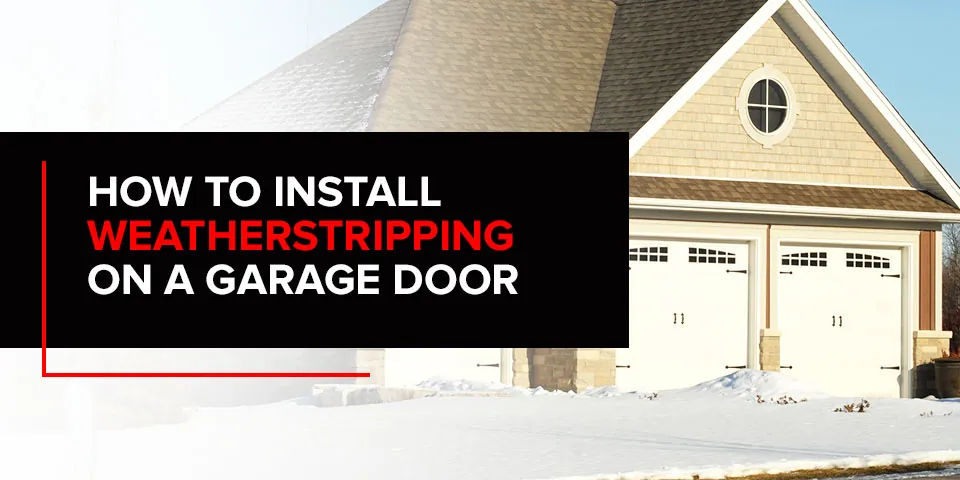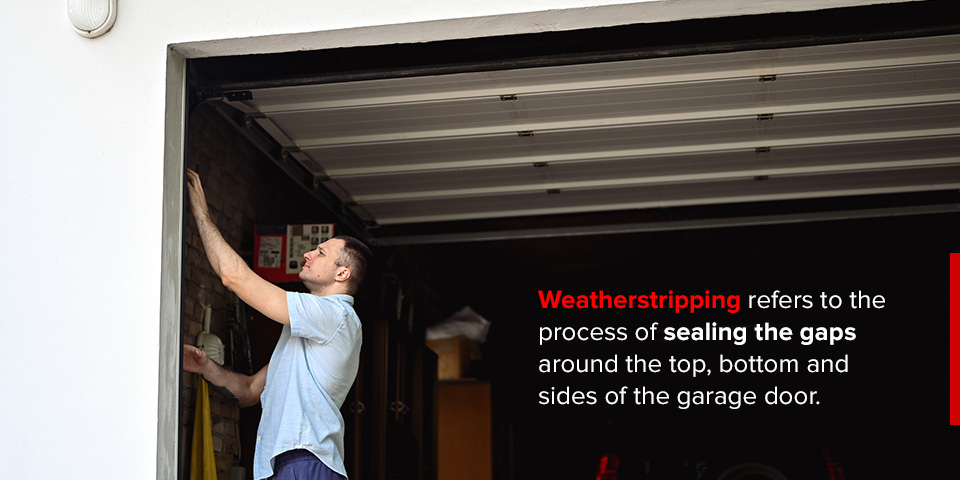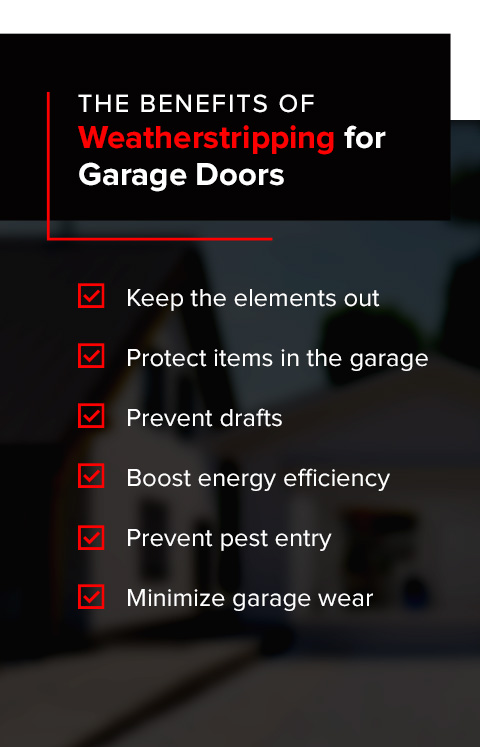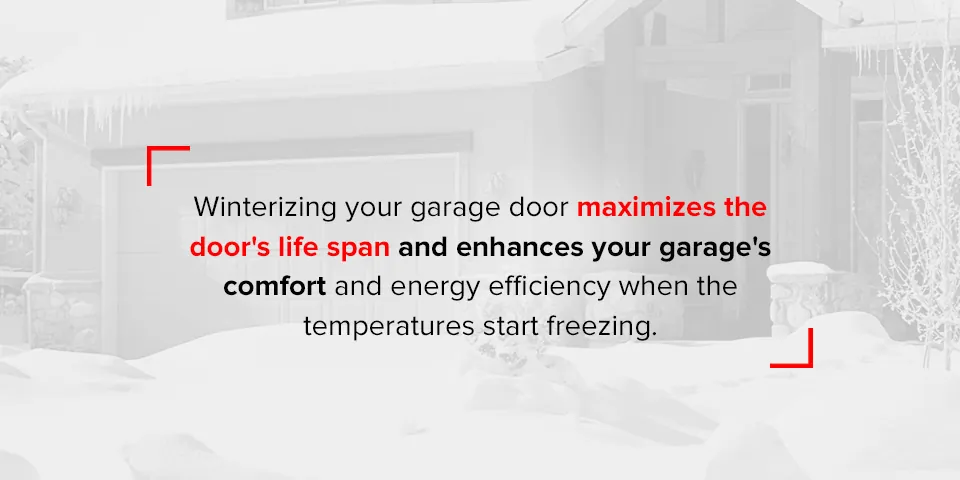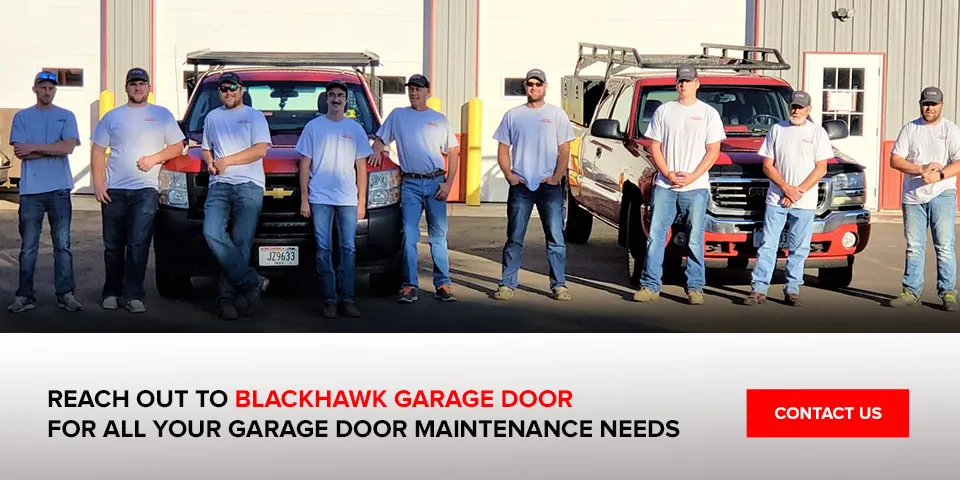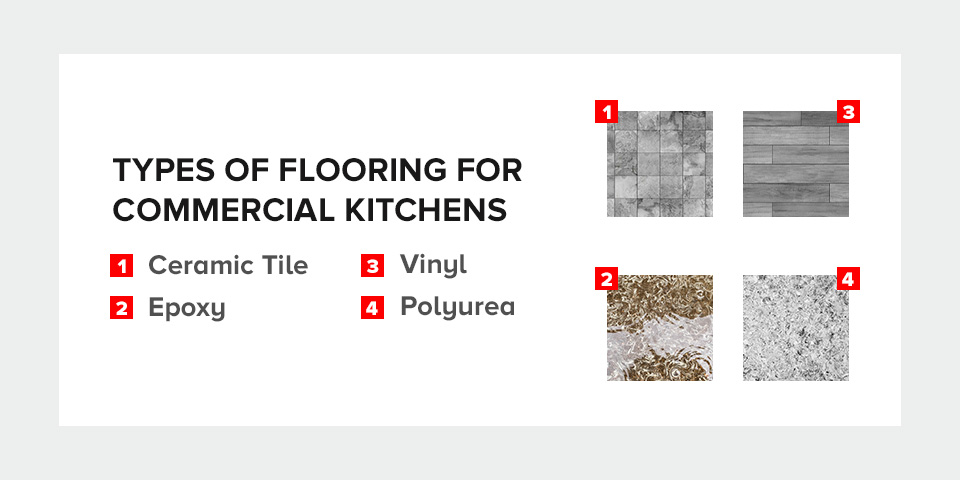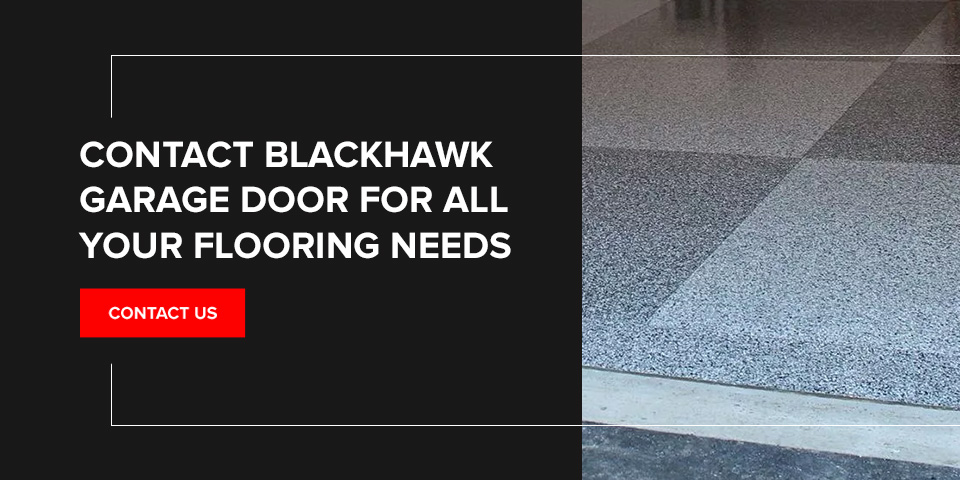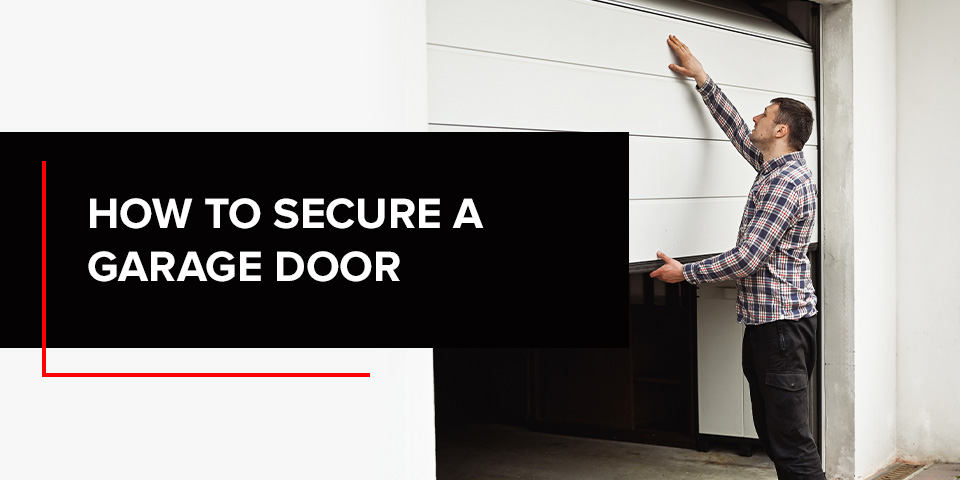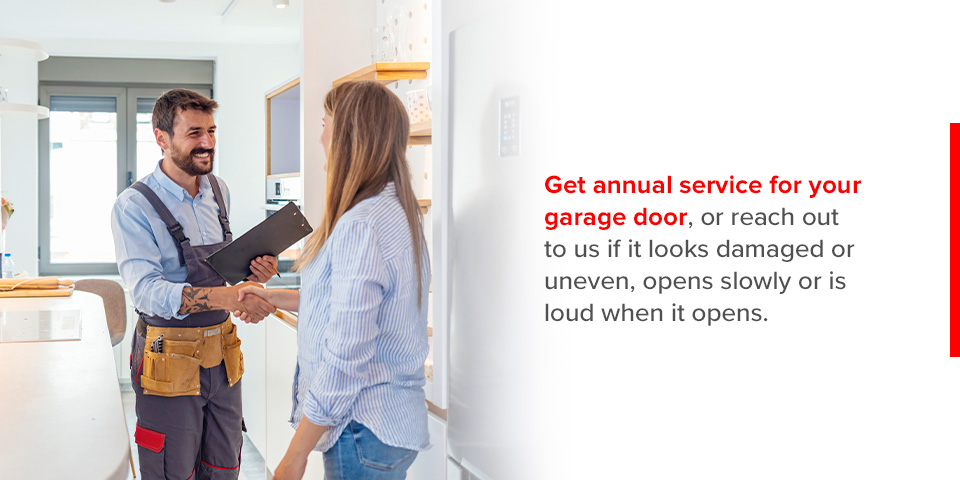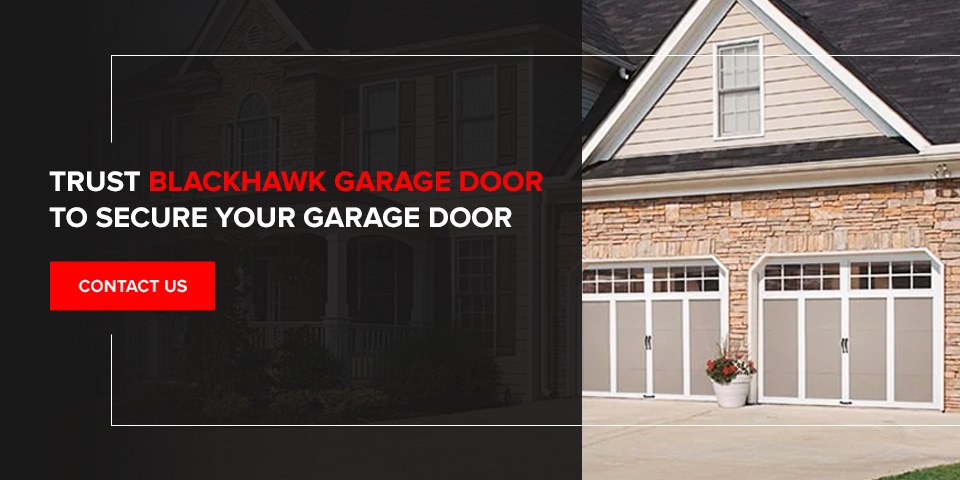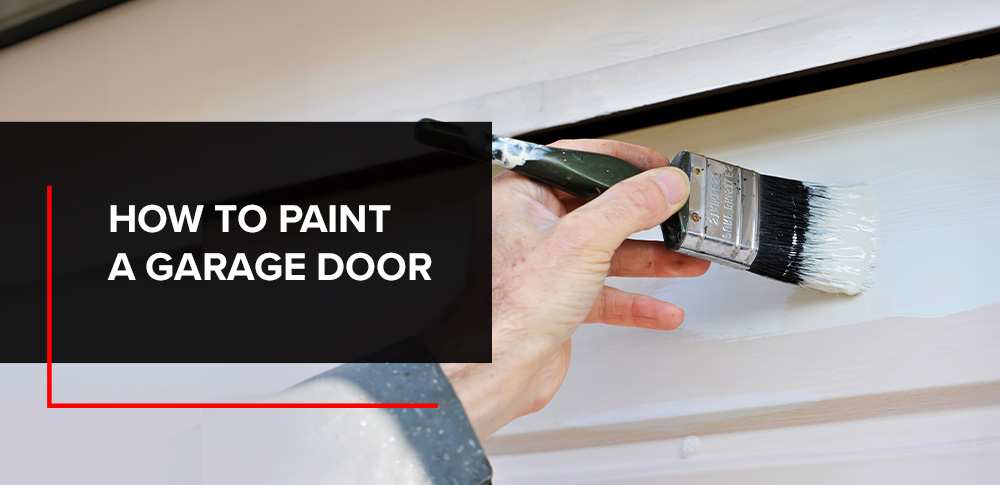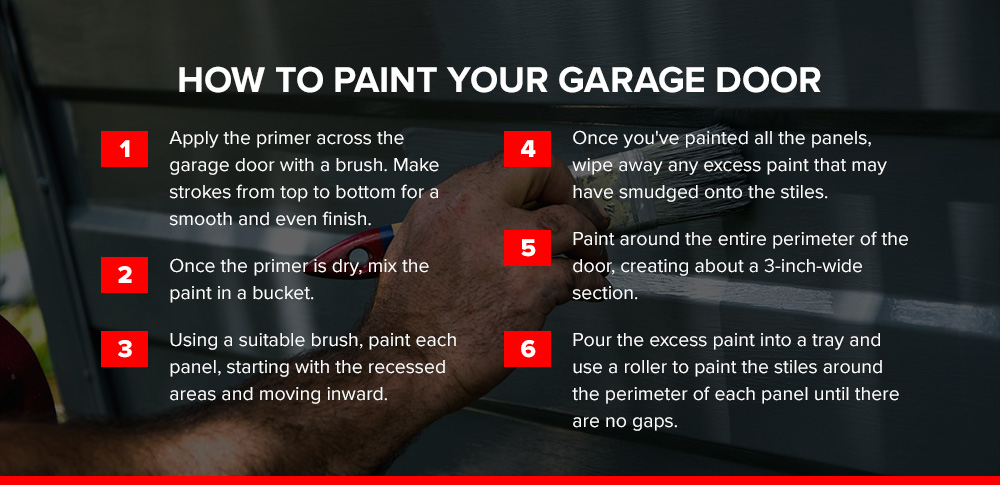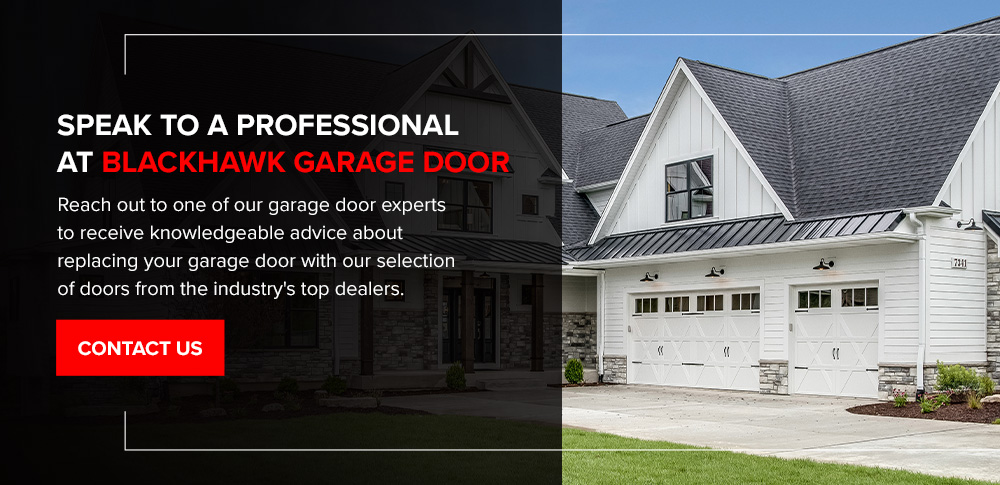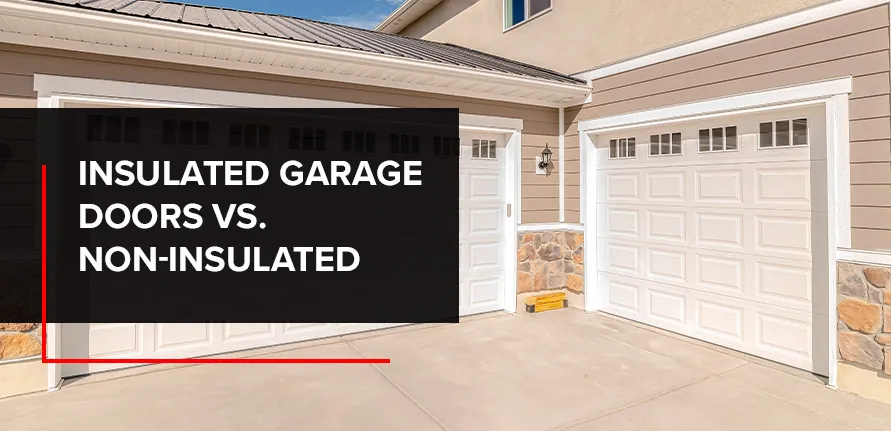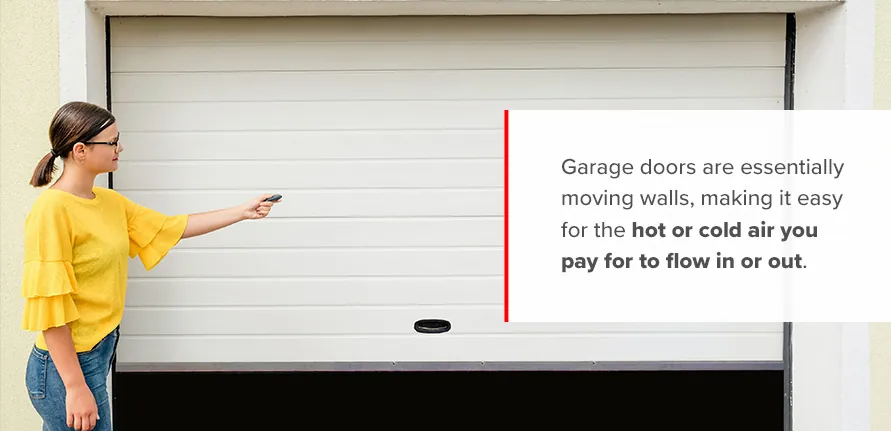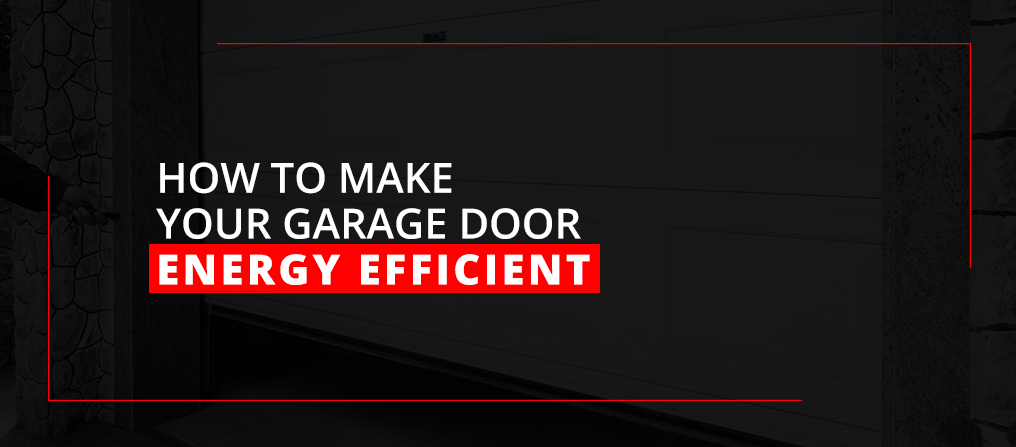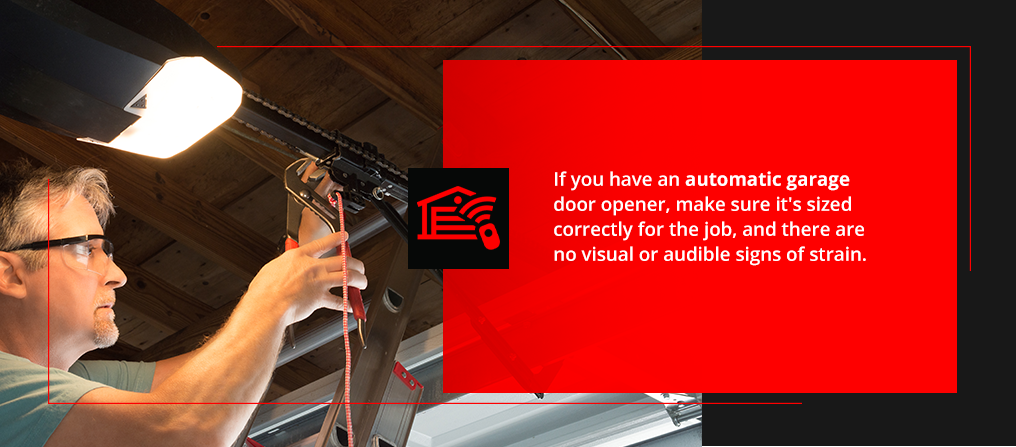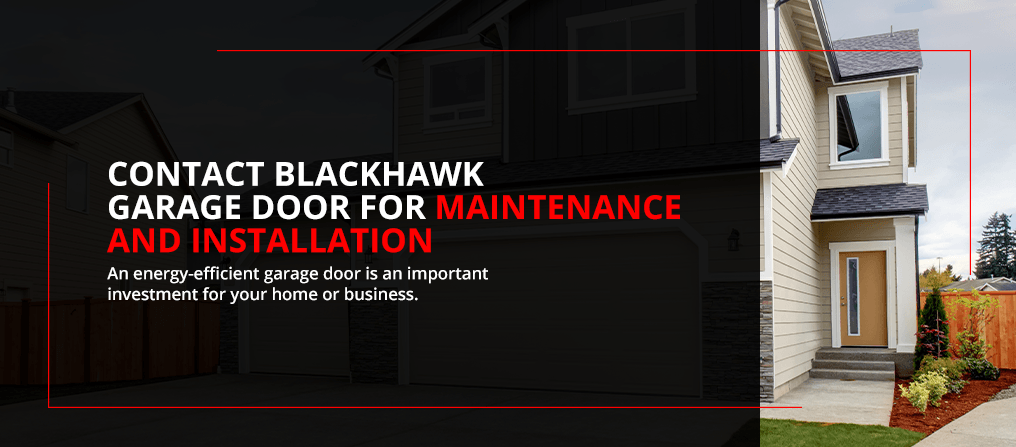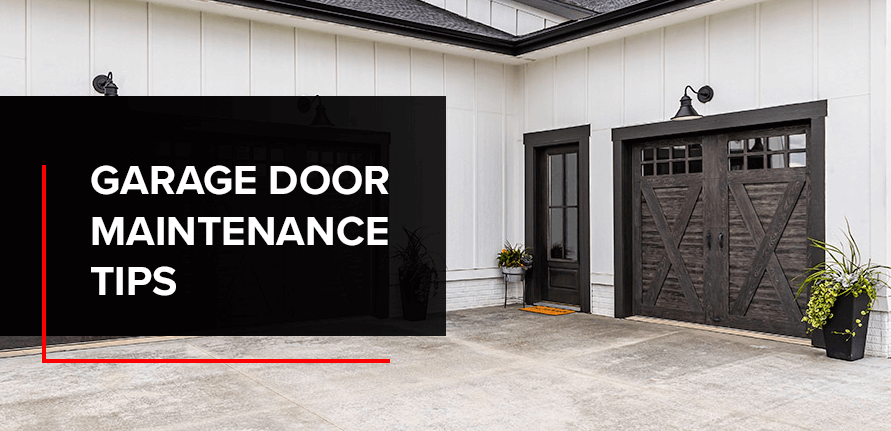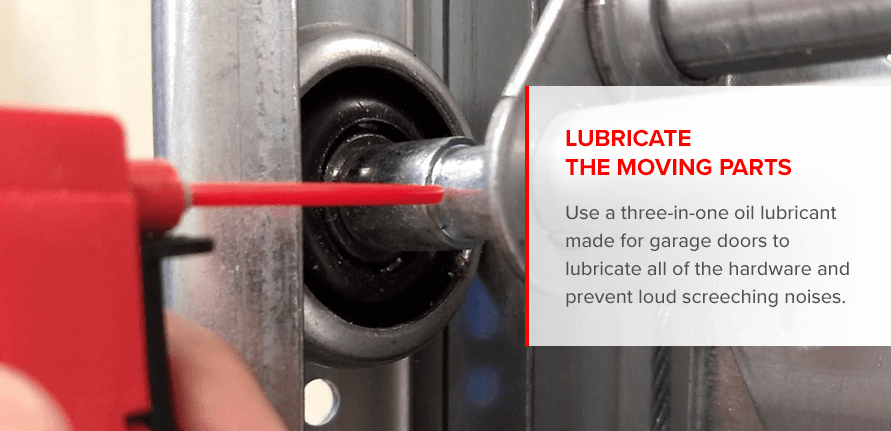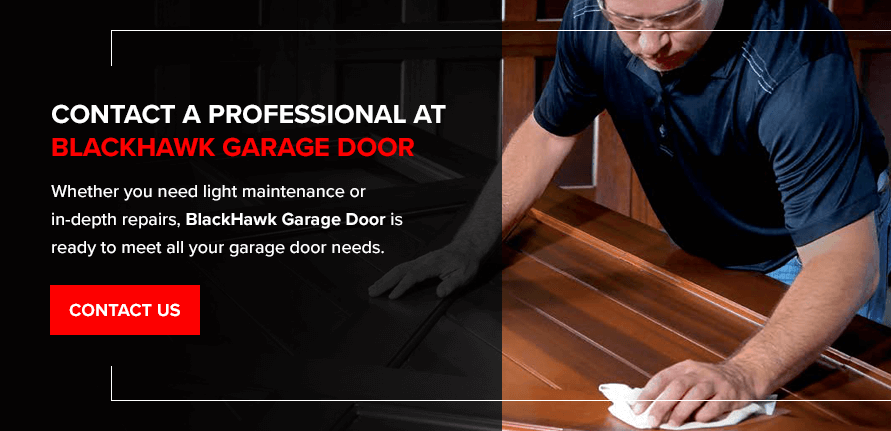How to Install Weatherstripping on a Garage Door
Garage door weatherstripping is essential in sealing the gaps around your doors and windows to create an optimal indoor environment in your garage and home. It can also improve the garage’s energy efficiency and usability.
You may need to install new weatherstripping on your garage door if it is insufficient, worn or damaged. Understanding the benefits, types and factors to consider when choosing whether stripping will help you make an informed decision with a positive return on investment.
What Is Weatherstripping?
Weatherstripping refers to the process of sealing the gaps around the top, bottom and sides of the garage door. It involves adding a seal that lines the garage door frame to prevent the entry of unwanted external elements, like water, debris, bugs, dirt and dust. Without weatherstripping, your home is more vulnerable to extreme temperatures, and you may notice increased utility bills.
Garage door weatherstripping is available in various materials with distinct properties, advantages and disadvantages. These include:
- Rubber: Rubber is a classic weatherstripping choice, available in different densities and thicknesses to suit different climates. It’s the best choice for areas with freezing winters because it remains flexible for extended periods.
- Vinyl: This affordable weatherstripping option this great for keeping drafts and moisture out. It’s resistant to mold and mildew growth and ideal for installation in rainy, humid or windy climates.
- Silicone: This material is superior in preventing the entry of air, water, dirt and dust. Silicone is highly durable and remains flexible, making it effective in extreme environmental conditions.
- Brush seals: These comprise tough metal or synthetic bristles that fill the gaps between your garage and the floor. They’re perfect for uneven garage doors and help regulate the temperatures inside the garage by keeping warm air in and cold air out.
- Foam (closed-cell): This material is a lightweight and flexible polyethylene or polyurethane ideal for sealing the gaps between garage doors and floors. It provides superior garage insulation but may not be as durable as other weatherstripping materials.
- Metal: Metal weatherstripping is a heavy-duty option that is incredibly durable and suitable for areas with freezing temperatures and heavy snowfall. Steel and aluminum are popular metal weatherstripping options, but ensure they’re coated against rust and corrosion for longevity.
Types of Weatherstripping for Garage Doors
Weatherstripping for garage doors can be categorized into three main types. Learn more about each type below.
Bottom Seals
Also known as door sweeps, these are long strips of rubber or vinyl attached to the bottom of your garage door to seal the gaps between the door and the floor. They’re readily available in a standard shape that fits the bottom of most modern doors.
Door sweeps are relatively easy to install using a steel, aluminum or PVC retainer. However, if you have a wooden garage door, you may need an aluminum or galvanized fastener to make your door compatible with them. They can be adjusted for uneven thresholds. To avoid the drag, opt for automatically retracting door sweeps that also increase durability.
Threshold Seals
Unlike door sweeps, threshold seals are attached to the floor instead of the garage door. They fill the gaps between the floor and garage door but often must be combined with a bottom seal to keep out all the elements. Nonetheless, threshold seals effectively keep water, dust and debris out of your garage while helping maintain the indoor temperatures.
Threshold seals are made from durable rubber, vinyl or aluminum, making them solid and sturdy enough to drive over without damage. They’re the best if your garage door meets the floor asymmetrically or the driveway slopes toward the garage.
Tension Seals
Also known as the V strip, it’s weatherstripping shaped like a V to create a tight seal along the garage door’s length. They’re available in aluminum, copper or stainless steel materials shaped to securely attach to the sides and top of the garage door.
Tension seals are relatively easy to add to your system. When properly installed, they are invisible and blend into many surfaces. However, they can only be installed on flat and smooth surfaces and may increase the garage door’s resistance.
The Benefits of Weatherstripping for Garage Doors
Weatherstripping has many aesthetic and functional advantages for your garage. It’s essential to choose the right weatherstripping and have it installed and maintained correctly so it can continue serving you for the long term.
The following are the main benefits of weatherstripping your garage door:
- Keep the elements out: Weatherstripping prevents snowmelt, rain, dust, hail, wind, dirt and debris from seeping into your garage. This protects your garage and home’s interior from water damage and the formation of mold and mildew and prevents the wear and tear of the doors and floors.
- Protect items in the garage: A weatherproof garage door keeps elements and pests out that could damage the belongings in your garage. It’s especially effective in protecting items that could be negatively impacted by moisture because gaps at the bottom of your door can let in dampness.
- Prevent drafts: Cold air or drafts can enter through the gap between your garage door and the floor, causing temperature imbalances. Weatherstripping prevents drafts inside the garage, maintaining a comfortable and pleasant space usable for various entertainment and workshop applications.
- Boost energy efficiency: Weatherstripping keeps uncomfortably warm weather out during the summer months and improves the effectiveness of insulation against cold temperatures in the winter. This minimizes your home’s heating and cooling energy losses, leading to significant energy cost savings.
- Prevent pest entry: Weatherstripping deters pests, preventing them from wreaking havoc in your home or destroying the belongings stored in your garage. Keeping pests out of your garage saves you the money you may otherwise need to spend on pest removal services and replacing your possessions.
- Minimize garage wear: When water enters your garage, it freezes, causing ice damage to the floors and accelerating the door’s wear and tear. Water pipes running through the garage are vulnerable to bursting when exposed to extremely cold temperatures and freeze damage.
How Do I Know If I Need Weatherproofing?
Weatherstripping typically lasts and remains usable for two to three years after installation. However, annual inspections are necessary to determine whether it’s still as effective as when it was first installed. Below are telltale signs you need to add new or replace your garage door’s weatherstripping:
- Visible damage: If you notice cracks, rips or visible wear and tear, the weatherstripping likely needs updating. Look for less obvious indications, like brittleness, flaking or warping. Rust and corrosion around your garage door can also be a sign.
- Drafts or air leaks: Do you feel drafts seeping into your garage from the bottom, top or sides of the door? You probably require new weatherstripping.
- Moisture infiltration: Check for puddles of water forming around or near the base of the garage door after precipitation. This is a sign your current weatherstripping is underperforming.
- Difficulty closing the door: Overly worn weatherstripping can cause improper alignment and resistance when closing your garage door, and you likely need to upgrade.
- Light gaps: If you notice a stream of light around the garage door, the weatherstripping may be damaged or worn.
While you can evaluate your weatherstripping yourself, partnering with garage door experts helps you identify other potential issues with your garage doors. While at it, they can conduct preventive garage door maintenance to ensure it’s ready for the harsh winters.
How to Install Garage Door Weatherstripping
Adding or replacing weatherstripping on your garage door can be a do-it-yourself project, especially if the door is working well. Nonetheless, working with professional garage door experts ensures your weatherstripping is installed effectively for longevity.
The following are general instructions for installing any weatherstripping to your garage door.
1. Take Your Door’s Measurements
Measuring your door before investing in weatherstripping ensures you get enough material to seal your garage door entirely and provide you with a positive return on your investment.
Measure the width, the length and the thickness between the floor and the door to determine how many weatherstripping pieces you need. Use a tape measure to get accurate and precise measurements for a snug fit of the weatherstripping.
2. Gather Installation Supplies
Collecting your weatherstripping installation materials and supplies beforehand ensures the process goes smoothly. Some of the must-have installation supplies include the following:
- Tape measure
- Cleaning supplies
- Drill or screwdriver
- Screws or nails
- Construction adhesive (for threshold seals)
- Utility knife or scissors
- Caulk and caulk gun
- Weatherstripping kit
- Gloves
3. Clean the Surface
Clean your garage floors and wipe the door frame to remove dirt and debris. This helps with the proper adhesion of the weatherstripping. You can go the extra mile to wipe down the floor and garage door with a degreaser if the surfaces are oily or greasy. Cleaning the surfaces also ensures longevity by minimizing the risk of bumping.
4. Install Weatherstripping
You need to cut your weatherstripping to the exact size of your garage door for a perfect fit. You don’t want weatherstripping too long or short, preventing proper functioning.
To correctly install your weatherstripping, follow the manufacturer’s instructions closely. Most DIY-friendly options come with adhesive backing, so you can simply peel and stick it to the top, bottom and sides of the door.
Start attaching the weatherstripping from the center and move outwards to avoid wrinkling and bubbling. If your weatherstripping requires screwing or nailing into place, be sure to use finishing nails every few inches to secure it. Aluminum and galvanized nails are the best because they don’t easily corrode or rust.
Installing threshold seals requires more precision, so you want to mark the floor with chalk or a permanent marker. Carefully apply the construction adhesion along the edges where the seal will sit, then place the threshold seal and press it into the adhesive. Give your the threshold strip at least a day before driving over it.
5. Test and Adjust As Needed
You want to ensure your weatherstripping works as intended without jamming or damaging it. Start by opening and closing the garage door to check that it’s oriented properly and doesn’t catch on the weatherstripping. With the door closed, inspect the seal for any gaps from the inside.
Other Ways to Weatherproof Your Garage Door for Winter
While weatherstripping is an effective method of garage door weatherproofing with many benefits, there are other ways you can prepare it for the winter.
Winterizing your garage door maximizes the door’s life span and enhances your garage’s comfort and energy efficiency when the temperatures start freezing. The following are practical tips for winterizing your garage door:
- Schedule regular maintenance: Before the start of the winter, inspect your garage door, its tracks, opener and safety sensors to ensure they’re working optimally. Perform necessary tuneups to prevent minor issues from worsening as the snow packs around different parts.
- Lubricate moving parts: Metal garage door parts like springs, hinges and rollers need regular maintenance and lubrication to keep them running smoothly. Avoid common household lubricants and stick to non-silicone options that don’t quickly freeze or collect dirt and debris.
- Add insulation: Most modern garage doors have built-in insulation to keep the garage warm and prevent moisture buildup. If you have an older model door, you should invest in insulation to minimize the risk of moisture buildup and freezing, which can prevent your garage door system from operating correctly.
Frequently Asked Questions
Here are some commonly asked questions and answers about weatherstripping and garage door winterization methods.
How Long Should Garage Door Weatherstripping Last?
Good quality weatherstripping typically lasts between two and three years. Its actual lifespan is determined by the type and material of the weatherstripping, the elements it’s exposed to, the traffic through the door and how often it is opened and closed. Regular inspection and maintenance of the weatherstripping may ensure it lasts longer.
Do I Need to Weatherproof My Garage Door?
Yes, you need to weatherproof your garage door to keep the rain, snow and cold temperatures outside during the winter. Weatherproofing makes your garage more comfortable and livable while protecting your home’s interior and belongings.
When Should You Replace Weatherstripping on the Bottom of a Garage Door?
If your weatherstripping turns hard and brittle, it is due for replacement. Other signs include cracks, rips and tears. You should also plan for replacement if you see a light at the bottom of your garage door or feel drafts.
Reach out to BlackHawk Garage Door for All Your Garage Door Maintenance Needs
While you can install weatherstripping yourself, contacting a professional is a worthwhile investment because they can handle other garage door repairs with expertise and precision. At BlackHawk Garage Door, we offer comprehensive garage door services, including installation, maintenance and repair in Baldwin, Wisconsin, Bloomington, Minnesota, and the surrounding areas.
Contact us today to schedule weatherstripping installation and your other maintenance needs.
Best Flooring for Commercial Kitchens
When shopping for flooring, you would likely consider its implications before you commit. The decision-making process is even more weighty if you’re running a commercial kitchen. This environment demands a robust floor type that can withstand the rigors of commercial space, from high traffic to spills.
What is the best floor for a commercial kitchen? Explore what you need to know to select the perfect commercial-grade flooring for your restaurant.
What Is Commercial-Grade Kitchen Flooring?
Commercial-grade flooring refers to the types of materials designed to withstand the demands of commercial areas, which typically involve high foot traffic, spills, stains and weight from heavy equipment. Compared to residential flooring solutions, commercial kitchen floors are tougher, more durable and suitable for the busy atmosphere of the food industry.
According to the Minnesota Department of Health’s administrative rules for retail food establishments, flooring materials should be smooth, nonabsorbent, durable, grease-resistant and easy to clean. While you can use different flooring materials based on the needs of your establishment, they must follow manufacturer specifications.
These guidelines underscore the importance of choosing proper flooring materials for food establishments like restaurants. Considering the need for a durable material that doesn’t absorb moisture and can resist grease, commercial-grade flooring is the most practical solution.
How to Choose Commercial-Grade Flooring
The best floor materials for commercial kitchens possess qualities that make them ideal for that environment. Look for these features when choosing kitchen floor materials for your restaurant:
- Antimicrobial: Floors that act as safe spaces for bacteria to thrive are hazardous in food preparation areas. Antimicrobial flooring materials have qualities that discourage the buildup of dirt and germs. These floors accommodate thorough cleaning to ensure no areas harbor microorganisms.
- Durability: Besides bustling with long hours of foot traffic, commercial kitchens are also exposed to damaging conditions like constant spillage, scratches, heavy bumps and thermal shock. Additionally, regular cleaning uses strong chemicals to protect against microorganisms. For these reasons, select durable flooring materials that can withstand daily wear and maintain longevity.
- Slip resistance: Safety should be a top priority when selecting floors for commercial kitchens. As a work area with high foot traffic, a commercial kitchen increases the risk of slipping due to moisture and greasing from oil spills. Anti-slip flooring lowers the risk of serious injuries.
- Strong moisture barrier: Commercial kitchens are exposed to increased levels of moisture and spillage. They also need to be mopped regularly. Consider a flooring material with a high resistance to water damage due to a strong moisture barrier. When shopping for materials, look for the nonabsorbent feature.
- Easy to maintain: Hygiene in a commercial kitchen is crucial, and it demands a floor that is easy to clean and maintain. These floors have features like stain and water resistance, allowing regular cleaning and scrubbing using basic products. Additionally, consider ongoing maintenance and repairs to ensure long-term cost-efficiency.
Types of Flooring for Commercial Kitchens
Various types of commercial kitchen flooring are available, appealing to buyers for different reasons, such as aesthetics and affordability. Here is an overview of the different options on the market.
Ceramic Tile
Tiles are timeless flooring materials that have been a reliable option for decades due to their durability and resilience. However, tiles are more suitable for residential flooring because they lack the qualities to withstand the demands of a commercial establishment. Since ceramic tiles are even weaker than porcelain ones, they may not fare well in a commercial kitchen. They are also slippery when wet, which can be a serious hazard in a kitchen.
Generally, tiles are easy to clean and are present in many kitchens. But they are porous unless you opt for glazed ceramic or porcelain, which will perform until the grout lines weaken. Weak grout lines let water seep under the tiles and accumulate dirt and bacteria. Tiles will also crack due to foot traffic and equipment weight in commercial kitchens. As such, periodic replacement and regrouting to manage moisture retention, odors and general wear and tear are common with tiles.
Epoxy
Epoxy resin is one of the most preferred coating materials in the flooring industry, contributing to the renewed popularity of concrete floors. While epoxy is strong and can take on heavy use, it’s a temporary solution. Cracks and chipping are common, which is not desirable in a commercial kitchen where the floor is exposed to spills, chemicals and heavy objects. Epoxy floors are also not slip-resistant, which can lead to hazardous working conditions in the case of spills.
Another consideration is that epoxy flooring systems in Minnesota need approval from the regulatory authority to ensure adherence to specific guidelines.
Vinyl
Vinyl is a popular and luxurious flooring option, but it’s not common in commercial kitchens because it requires high maintenance and special care to provide long-term value. Vinyl’s maintenance requirements include wiping spills immediately and preventing sand, dust and grit, as they can cause damage. Spills also lead to an increased likelihood of falls, since vinyl floors are slippery when wet.
As resilient as the material can be, these levels of care are not practical in an environment where spills occur frequently and dirt builds up due to heavy foot traffic. In addition, Minnesota prohibits vinyl in kitchens, food preparation, deli and dishwashing areas unless it meets NSF Standard 52 or is recommended for use in these areas by the manufacturer.
Polyurea
Polyurea stands out as one of the best floors for commercial kitchens. As a coating material rather than a floor type, polyurea works with concrete to provide a robust, long-lasting, low-maintenance solution for residential and commercial spaces. Polyurea concrete coatings are considered a more reliable alternative to epoxy. They offer several critical advantages, making them one of the most effective commercial kitchen flooring options. These qualities include:
- Durability: Polyurea provides superior resistance to chipping, abrasion, moisture and chemical spills.
- Elasticity: Polyurea’s high elasticity accommodates floor expansions and contractions caused by temperature extremes, preventing cracking.
- Slip resistance: The final coat comes with anti-slip aggregate that provides friction, reducing the risk of slipping.
- UV resistance: Polyurea has excellent UV stability, allowing it to withstand sun exposure.
- Antimicrobial: Polyurea coatings can effectively combat bacterial growth and contaminants on the floor surface, which is critical in food preparation areas.
Commercial Kitchen Flooring FAQs
Here are some commonly asked questions about commercial kitchen flooring:
What Type of Flooring Is Best for a Commercial Kitchen?
There are multiple flooring options with diverse qualities, which means the best flooring material for you depends on your unique needs. However, if you consider the capacity to withstand the demands of commercial kitchens, polyurea has an edge over other materials.
How Much Does Commercial-Grade Kitchen Flooring Cost?
The cost of commercial flooring depends on the material. However, the typical range is $2 to $10 per square foot and rarely exceeds $20 per square foot.
How Much Does Polyurea Flooring Cost?
Polyurea flooring costs depend on various factors, such as floor size, condition and coating system. For a full estimate of polyurea flooring for commercial kitchens, it’s best to request a quote from a reliable provider.
Contact BlackHawk Garage Door for All Your Flooring Needs
Commercial floors demand superior performance to meet the conditions of the trade and adhere to regulatory compliance. Qualities such as durability, slip resistance, moisture resistance and easy maintenance must be a priority. Selecting the right flooring material can be tedious, but with the help of experts, it can be smooth and quick.
At BlackHawk Garage Door, we provide residential and commercial ployurea flooring solutions for customers in Minnesota and Wisconsin. Contact us today to learn about our polyurea flooring!
8 Tips for Making Your Garage Door More Secure
The front door, back door and windows of your home are the top three spots a potential burglar could use to break in. Another opening you shouldn’t forget is your garage door. Surprisingly, 9% of thieves attempt to break in through the garage. No matter the statistics, you’ll likely want to ask yourself, “How can I make my garage door more secure?”
Your garage stores many valuable items, from tools and sports equipment to your vehicle. It also allows access to your home, making garage door security vital. We’ve put together this guide filled with garage door security tips to show you how to secure your garage door and make your house and everyone inside safer.
1. Ensure the Door Closes
This is among the simpler garage door security tips. Many homeowners drive out of their garage and down the driveway, closing the garage door behind them — but they may not always watch to ensure it closes all the way. If you leave to run errands and don’t notice whether the garage door stays open, you’re inviting burglars into your garage and home. Wait a few extra seconds before driving away to save yourself the potential for a future disaster.
If your garage door isn’t shutting, you may have an issue with the opener or the sensor. Check that there aren’t any items blocking the path of the sensor and preventing your door from closing. Have a professional inspect your garage door system if you can’t see any obvious issues.
2. Change Your Opener Code
So, how secure is a garage door? That all depends on how safe you make it. Many homeowners have a PIN that lets them access their garage, and keeping that information private is essential. Only share this code with members of your household. If you ever have to share your PIN with someone else in an emergency or if they’re housesitting, change it when they’re done. You can also create a new code if you notice suspicious activity around your neighborhood. Pick a unique number that you don’t use for any other PINs.
It’s essential to change your garage opener PIN when you get a new system, as well. Many garage openers come with a factory-standard preset code, meaning a burglar could easily attempt to guess your PIN.
3. Use the Manual Lock
If you’re going away on vacation or don’t plan on using your garage for some time, use the manual lock to prevent a garage door break-in. Secure your garage door from the inside with a manual lock, often located at the center of the door.
You can also engage the manual lock if you experience a power outage. That will prevent anyone from forcing it open from the outside. Just remember to unlock it before you try to use your garage door opener again.
4. Keep Your Opener Remote Inside
Many homeowners have garage door openers in their cars, but keeping them there is not necessarily wise. If you park your car outside, you risk allowing a burglar to break into your vehicle, take the remote and open your garage. That leaves your home vulnerable until you replace the entire opener system and regain garage door security.
Bring your garage door opener remote inside when you get home or use an opener key fob to help keep your garage secure. It is convenient to leave the remote in your car, but if you want a garage door security tip that is quick and easy to execute, then try keeping the remote with your keys. By attaching the remote to your keyring, you will automatically bring it in from the car when you arrive home.
5. Maintain Your Door
Burglars can capitalize on broken locks, faulty windows and poorly maintained entryways. To know how to make a garage door more secure, you also have to understand how to maintain it. Routine maintenance keeps your garage safe for your family to use and can help prevent break-ins. Broken garage door panels, weak hinges and rusted bolts leave your garage door at risk for damage, which a thief could easily take advantage of.
For the best routine garage door maintenance, trust the professionals. Get annual service for your garage door, or reach out to us if it looks damaged or uneven, opens slowly or is loud when it opens. Those are all signs that your garage door needs a bit of upkeep, and we can diagnose and correct any issues your door may have.
6. Get a New Garage Door Opener
If you have an older garage door lift mechanism, you risk having a damaged or outdated system. Older technologies mean a burglar could copy the opener remote frequency onto another device. That gives them access to your garage as if they’re using the same opener you do.
For a secure garage door opener, choose newer models with advanced technology that create a rolling code. This means a burglar can’t duplicate the opener’s frequency onto another remote and access your garage. Consider a new garage door opener that will protect your home and give your door a smoother operation.
7. Secure the Emergency Release Cord
The emergency release cord for your garage door is a handy feature, but don’t let it be an access point for burglars. Some thieves use a method called “fishing” to push a wire hook through a gap at the top of your garage door. They’ll use the wire to grab and pull the release cord, which could open the door. While fishing is challenging and pulling the cord toward the door won’t always open it, it’s still a risk.
Secure your garage door release cord using a shield designed to cover the cord. That’s a much safer method of garage door security than cutting the cord or zip-tying it. You don’t want a thief to access the release cord, but you may still need to use it at some point.
8. Install Security Cameras
Adding security cameras is an excellent way to secure a garage door from the inside and provide protective surveillance outside. Placing cameras inside your garage and outside, particularly if you use the kinds equipped with motion detection and infrared night vision, will alert you to any activity and allow you to act quickly.
You will want to be strategic about where you place the cameras so they are out of reach from potential tampering and where they have the best line of sight with the most coverage. What’s more, cameras that use Wi-Fi allow you to access live footage, whether you are at home or out and about.
9. Secure and Cover Garage Windows
Typically, your garage will be windowless. However, some garage doors have windows built into them, and if you use the garage as a workspace or for other purposes, you might have built-in windows. If your garage has windows, it is best to ensure they are always secured and latched shut when you go out. Routinely check for any damage or signs of tampering.
Additionally, regarding security for garages, it is wise to put some burglar-proofing on the windows or at least place windows so the garage contents are obscured. Alternatively, you can cover the windows with blinds and curtains or install shutters internally.
10. Lock the Garage Door Track
Although your garage door might have a manual locking mechanism built into it, adding a padlock to the garage door track is another way of adding further protection and securing it from the inside. This is an added measure to the ones already implemented, and although you could even go so far as unplugging your garage door motor, adding a padlock to the tracks adds another physical barrier that burglars will struggle to get through.
To add the padlock, a hole may already be located just above the garage door wheels. Otherwise, you can drill one big enough to fit your lock of choice. However, if you intend to drill into the track, please speak to your garage door provider to ensure this won’t void the warranty. Alternatively, talk with your local garage door professionals to come and assist you in providing the added security for your garage.
Trust BlackHawk Garage Door to Secure Your Garage Door
Now that you know how to secure garage doors, you can take steps to make your property safer with BlackHawk Garage Door. Our family-owned business provides dependable service in the Twin Cities and throughout Western Wisconsin. Whether you need garage door repairs, residential garage door products or even commercial garage door products, our expert technicians are ready to help. With competitive pricing and many technicians with over 10 years of experience, you know we’ll provide thorough and quality maintenance and installation to meet your garage door needs.
Regain peace of mind when you secure your garage door with BlackHawk Garage Door. Contact us today for free and honest estimates.
How to Paint a Garage Door
Your garage door is likely the first thing you see when you leave and return home. If it’s looking dull, rusty or in need of a touchup, painting your garage door might do the trick. Learn everything you need to know about painting your garage door in our guide.
Can You Paint a Garage Door?
Yes, you can paint garage doors. Painting is a viable option if your garage door is dull and you want a new look. It’s a quick and relatively easy way to achieve your desired design. However, if your garage door is too old, painting might not do the trick, as you may need to replace it. In this case, you can repurpose your garage door by painting over it and displaying it as custom artwork or using it as a chalkboard or headboard.
Whether you have a metal, wood or vinyl door, you can paint over it without problems. A unique paintwork or a neutral tone can greatly improve curb appeal and make your yard stand out.
What Are the Best Practices for Painting a Garage Door?
To get the best results when you paint your garage door, you’ll want to use the right paint and materials and consider the weather.
What Is the Best Paint to Use?
Choosing the best paint for your garage door is essential, as some may not be suitable for certain materials. For example, if you have a metal door, you should use metal garage door paint like acrylic latex paint so it adheres properly and gives you a flat finish. If you have a steel door, you wouldn’t want to apply an oil-based paint as it could take much longer to dry. Make sure the paint you choose is compatible with your door’s material.
Additionally, no matter the type of garage door you have, you should always prime it before you paint to get a flawless look and make the color pop.
Does Weather Affect the Paint Job?
The weather needs to be cool and dry for the perfect paint job. Check the forecast for at least two consecutive days to ensure suitable conditions. If it rains, it may wash away some of the paint and leave you with a rough finish. Hot, humid weather can cause certain areas to dry quickly, which results in a patchy look.
What Materials Do You Need?
Create a checklist before you start painting so you can have everything you need within reach. Here are some of the materials and tools you may require:
- Paintbrush
- Primer and suitable exterior paint
- Safety goggles
- Rubber gloves
- Respirator mask
- Sandpaper
- Painter’s tape
- Wire brush
- Step ladder
How to Paint Your Garage Door
Painting a garage door is easy once you have the right tools, paint and weather. Here’s a general overview of how to do it:
- Apply the primer across the garage door with a brush. Make strokes from top to bottom for a smooth and even finish.
- Once the primer is dry, mix the paint in a bucket.
- Using a suitable brush, paint each panel, starting with the recessed areas and moving inward.
- Once you’ve painted all the panels, you can wipe away any excess paint that may have smudged onto the stiles.
- Paint around the entire perimeter of the door, creating about a 3-inch-wide section.
- Pour the excess paint into a tray and use a roller to paint the stiles around the perimeter of each panel until there are no gaps.
Remember to apply your painter’s tape in areas you don’t want to paint and remove it once the job is complete.
How to Paint Your Garage Door Frame
Learning how to paint your garage door frame can give your garage door that new look in just two easy steps:
- Paint the inside of the frame, starting from the edge of the door and working outwards.
- Once you’ve covered the entire door frame, wipe away any excess that may have smudged on the trim.
How to Paint Your Garage Door Trim
Reviving your trim is one of the best garage door painting ideas. It allows you to add a splash of color to your garage door without painting the whole thing, giving your property plenty of added curb appeal. Here’s how to paint the trim:
- Start at the top corner and paint the side edge of the trim. Stop at the point where it meets the wall.
- Dip the brush back into the paint to ensure it’s wet enough for clean strokes.
- Paint the face of the trim and continue until you’ve touched up all the gaps.
Frequently Asked Questions
Here are some common questions about garage door painting and our expert answers:
Is It Worth It to Paint My Garage Door?
If your garage door works perfectly, but you just want a fresh look, it’s worth painting it. However, if your garage door is damaged in any way, painting it won’t fix it. In that case, it’s best to have it repaired or replaced by a professional.
Will Painting My Garage Door Damage It?
Painting your garage door will not damage it, but don’t paint over it if it needs to be repaired. Doing so would be a waste of paint, and it may cover up the cause of the damage, making it hard to repair.
What Is the Best Paint for a Metal Garage Door?
Oil-based and acrylic paints are ideal for metal doors. They’re typically water resistant, which prevents rust and can be a game-changer for humid and coastal areas.
What Is the Best Paint for a Wood Garage Door?
Acrylic paints are ideal for wooden doors. The sun’s ultraviolet rays can wear wood down, and these paints repel them. Acrylic also dries quicker and provides a shinier finish.
How Much Does It Cost to Paint a Garage Door?
The cost depends on the supplies you need and the type of garage door you have. Typically, you can expect to spend a couple of hundred dollars or more. If your door is old or you want a different garage door look that paint can’t achieve, it may save you more money to replace the door with a newer model.
Speak to a Professional at BlackHawk Garage Door
Are you unsure whether to paint your garage door or replace it with a new one? At BlackHawk Garage Door, we’re here to help. Reach out to one of our garage door experts to receive knowledgeable advice about replacing your garage door with our selection of doors from the industry’s top dealers.
Additionally, we provide reliable garage door repair services to help you keep your garage door in top shape. Whether your door is dented or has an issue with the tracks, leaving repairs to the professionals is the safest option, and our team is ready to get your door back in working order.
Request an estimate today to get started!
Insulated vs. Uninsulated Garage Doors
If you’re getting rid of your old garage door or picking one out for your new home, you have many decisions to make as you shop for a new overhead door. With so many styles and materials to choose from, you have plenty of options to fall in love with. One crucial choice is whether to invest in an insulated garage door.
INSULATED vs NON-INSULATED GARAGE DOORS: WHAT ARE THE KEY DIFFERENCES?
Most garage doors offer insulation options, and making the right selection will affect your daily comfort and energy costs. Let’s weigh the pros and cons of insulating an overhead door to see if it’s worth it for you.
- Advantages of Insulated Garage Doors
- Considerations of Insulated Garage Doors
- Advantages of Uninsulated Garage Doors
- Considerations of Uninsulated Garage Doors
UNDERSTANDING A GARAGE DOOR’S R-VALUE OR U-VALUE
Whether you choose an insulated or uninsulated garage door, you will likely see that the door has an R or U-value rating. An R-value measures how well the door insulates against heat flow. A higher R-value indicates better insulation. A U-value measures how much heat can pass through the door by considering the entire assembly. Unlike an R-value, a lower U-value indicates better insulation.
WHAT ARE THE BENEFITS OF INSULATED GARAGE DOORS?
The difference between insulated and uninsulated garage doors is a thick foam layer. The foam allows the garage to retain heat in the winter and keep cool air inside during the summer.
Here are a few reasons to consider insulating a garage door:
1. THEY MAY RAISE YOUR HOME’S VALUE
Garage doors are a functional and stylish home improvement, making them an excellent way to increase your home’s value through benefits like:
- Boosting curb appeal
- Increasing energy efficiency
- Adding an attractive home element
2. THEY CAN HELP REDUCE YOUR ENERGY BILLS
Garage doors are essentially moving walls, making it easy for the hot or cold air you pay for to flow in or out. Insulated overhead doors make it harder for the air to escape, preventing your energy bill from skyrocketing to keep your home at a desired temperature.
An increase in energy efficiency means your garage will be more comfortable. If your garage is a working or living space, if your garage is a working or living space, you will invest fewer resources in heating or cooling. A more comfortable garage also means benefits like faster snow melt when you pull in your car and a cooler vehicle in the summer.
3. THEY HAVE A LOWER NOISE LEVEL
One of the biggest insulated garage door benefits is that they operate more quietly. The insulation acts as a soundwave absorber, making opening and closing the door less noticeable. This means you can have a garage share a wall with your home or have a bedroom above it without causing any major disruptions.
5. THEY ARE MORE DURABLE
Insulated garage doors have more material backing them, making them thicker and more durable. Greater durability also means your overhead door may last longer, as it can withstand daily wear and tear. Since an insulated garage door keeps your entire garage warmer, it will prevent the springs and other accessories from freezing, resulting in less of a need for garage door opener repair.
6. THEY OFFER BETTER OVERALL PROTECTION
Installing an insulated garage door allows you to protect a variety of temperature-sensitive materials in your garage. For example, an insulated overhead door can prevent paint and fertilizers from freezing or your car battery from dying.
CONSIDERATIONS OF INSULATED GARAGE DOORS
While insulated garage doors provide many benefits, they’re not for everyone. Some people don’t choose insulated doors because of downsides like these below:
1. INSULATED GARAGE DOOR COST
One of the main considerations for insulated garage doors is their cost. Most insulated overhead doors cost significantly more than uninsulated models. However, it’s important to consider the long-term benefits, such as lower energy bills and higher resale value.
2. RISK OF LEAVING YOUR GARAGE OPEN
Leaving your insulated overhead door open negates its benefits. One way to work around leaving your door open for extended periods is by installing an automatic opener with myQ® technology, which allows you to open and shut your door remotely so you can continue enjoying the full benefits of your overhead door.
ARE UNINSULATED GARAGE DOORS WORTH IT?
Uninsulated garage doors are ideal for mild climates or homes that do not need to worry about staying warmer or cooler. Some advantages and considerations of uninsulated overhead doors include:
ADVANTAGES OF UNINSULATED GARAGE DOORS
Uninsulated garage doors are a smart investment for some homeowners. While they’re not for everyone, an uninsulated overhead door has some plus sides:
1. THEY’RE LESS EXPENSIVE
The primary advantage of an uninsulated garage door is its lower price. When comparing insulated vs. uninsulated garage door costs, the uninsulated version of your chosen door will always cost less.
2. THEY WORK WELL FOR DETACHED GARAGES
With a detached garage, your heating system isn’t in the same building, and having an insulated garage door will not affect your home’s energy efficiency. Your insulated garage also won’t be much warmer without a heater inside. If you use a detached garage as living or working space or storage, it might still be worth it to get an insulated overhead door. It will make any space heater or heat pump more efficient.
CONSIDERATIONS OF UNINSULATED GARAGE DOORS
Uninsulated garage doors have some major drawbacks to consider:
1. THEY’RE NOT ENERGY-EFFICIENT
The main drawback of an uninsulated door is that it provides no heat resistance and lets your heating and air conditioning escape outdoors. Energy waste is a significant concern for people with attached garages. If your garage is next to climate-controlled rooms in your house, the heat loss through your garage will make your HVAC system work harder.
2. THEY MAKE YOUR GARAGE LESS COMFORTABLE
Without heat flow resistance, your garage will feel much like it is outdoors, no matter the season. If you spend time in the garage, you might prefer the added comfort of insulation.
3. THEY MAY REDUCE YOUR STORAGE OPTIONS
With more temperature fluctuation, many of the items you store in your garage are at risk. Wood may expand and contract more dramatically, causing cracks. Moisture-sensitive items will be susceptible to more humidity, and liquids may thicken. If your garage is mainly for storage, an uninsulated garage won’t provide the protection you need.
4. THEY’RE LESS DURABLE
Uninsulated garage doors are hollow. A single-layer door won’t even have an inside face. This feature means the door is more likely to dent. Continually hitting your garage floor may cause extra wear, especially if it doesn’t have a protective floor coating. Tapping the door with your car or a soccer ball might also leave a dent.
5. THEY’RE NOISIER
Without insulation, a steel garage door has an empty cavity inside. As the door opens, vibrations rattle and echo inside that empty chamber. While some people are content with tuning it out, others can’t ignore it. The noise might wake people up late at night or early in the morning.
WHICH TYPE OF GARAGE DOOR IS BEST FOR ME?
The choice of whether an insulated vs. non-insulated garage door is best for you will largely depend on the climate and your own needs. If you live in an area with harsh winters, you may want to invest in an overhead door with a higher R-value. A lower R-value or uninsulated garage door may work better if you live in a milder climate and don’t use your garage as a living or working space.
CONTACT BLACKHAWK GARAGE DOOR FOR NEW GARAGE DOORS
At BlackHawk Garage Door, we have an excellent selection of garage doors to fit any home and budget. BlackHawk Garage Door is a family-owned business providing dependable service in the Twin Cities and throughout Western Wisconsin. Contact our overhead door experts online or give us a call to learn more about our garage door options or request your free estimate.
How to Make Your Garage Door Energy Efficient
[lwptoc depth=”1″ numeration=”none” colorScheme=”inherit”]
Garages are very beneficial for homeowners. They offer a safe storage place and add extra square footage — but your garage can also be wasting money and electricity. One of the largest culprits for garage-related energy waste is an old, damaged or poorly insulated garage door.
Energy-efficient garage doors are an excellent asset because they provide:
- A more comfortable space: If your garage doubles as a workshop, gym, studio or apartment, then a comfortable temperature is essential. Energy-efficient garage doors prevent costly and uncomfortable temperature fluctuations.
- An eco-friendly alternative: About 40% of the United State’s energy consumption goes toward producing electricity. Much of this energy produces greenhouse gases and other pollution. The less power you consume, the more environmentally-friendly your home will be.
- Lower energy costs: Fluctuating garage temperatures are costly to keep up with, especially if your garage is attached. If the temperature is unstable in your garage, it can lower or raise the temperature inside your house.
- Increased resale value: Insulated garage doors, automatic door openers and garage insulation are great ways to boost your home’s resale value because they promise lower utility costs. They also save a potential buyer from having to make upgrades themselves.
Read on to learn more about how to make your garage door efficient.
Insulate the Door
The best way to insulate a garage is to start with the door. An insulated door can help maintain a more comfortable and controlled temperature inside your garage, keeping it up to 12 degrees warmer in the winter and 20 degrees cooler during the summer heat. Garage door insulation can also block out unwanted noise transfer, which is ideal for those who have garage workshops. You can measure an insulated garage door by its R-value. R-value refers to the level of effectiveness for each layer of insulation based on factors like its density, age and type.
When it comes to insulating your garage, you have two choices — use a do-it-yourself insulation kit or consult a professional garage door technician to help. DIY kits come with foam board insulation, reflective insulation or batt insulation to hang along the inside of your door. While this may be an inexpensive solution, a professional garage door technician will get the job done right and take one thing off your to-do list!
Seal Garage Door Cracks
If there are cracks between your garage door and the walls or floor, hot and cold air can easily flow in and out throughout the day. If you rely on an air conditioner or heater to regulate your garage’s temperature, this outside airflow will cause a spike in your energy consumption — and your bill. To seal garage door cracks, apply weatherstripping in areas with large gaps. Weatherstripping is a firm, sometimes flexible strip that fits around your door to prevent lost energy and temperature fluctuation. As you open and close your garage door, weatherstripping on the bottom will not break or scratch because it is made of durable rubber, vinyl or silicone, though some may be made of aluminum or a similar metal.
If your garage door already has weatherstripping, check that it is still attached correctly and in good condition. Signs that indicate possible weatherstripping damage include:
- Excessive drafts around your door.
- Visibly worn or damaged stripping with tears, cracks, dents or corrosion.
- Water puddles, insects or other evidence that the stripping is no longer doing its job.
Contact your garage door servicer for further guidance about how to seal garage door cracks.
Upgrade Your Garage Door Opener
If you have an automatic garage door opener, make sure it’s sized correctly for the job, and there are no visual or audible signs of strain. The harder a garage door opener has to work to move your door, the more energy it consumes in the process. You could also consider upgrading from a standard automatic garage door opener to one with built-in smart technology.
Smart garage door openers tend to use less electricity than a standard automatic door opener because you can program them to turn on and off at specific intervals throughout the day, rather than standing idle. With automatic closing, you also eliminate the possibility of accidentally leaving your door open when you leave your home for the day — an accident that is both a security risk and a significant energy waster.
Replace Your Door With a More Energy-Efficient Garage Door
A damaged or worn garage door is one of the quickest ways to rack up a hefty energy bill. Replace your garage door to reduce garage energy consumption if you have any holes, cracks, rust or excessive dents and scratches. When choosing a new, more efficient garage door, consider the following:
- Material: Each garage door material has different advantages. For example, steel is strong and resistant to most damage. When constructed out of several layers or combined with insulation materials, it’s also great for temperature regulation. Wood, composite wood and doors made of blended materials are also suitable for insulation.
- R-value: Always check the listed R-value for a garage door before making your investment. The higher the R-value, the better it will be for insulation.
- Windows: Garage door windows can be very beneficial, especially if you want to save money by using more natural light. That said, garage door windows can also be a source of energy loss for many homeowners. To combat this, make sure your windows are installed correctly, and there are no gaps or cracks around the windows. You can also consider adding an insulated or low-emissivity glaze to the glass to prevent excess heat transfer.
Schedule Preventative Garage Door Maintenance
Regular garage door maintenace is the best way to address minor concerns before they turn into larger, more energy-wasting issues later. With preventative maintenance from BlackHawk Garage Door, a specialist will visit your home at least once per year to inspect your door’s performance and appearance. They will check each part of your garage door, including the track, nuts, bolts, hardware and springs. The technician will also apply complete lubrication to all moving parts and address any additional concerns you might have.
Additional Tips for an Energy-Efficient Garage
Once you have made your garage door more energy-efficient, you can take some additional steps to create a more energy-efficient garage, including:
- Unplug all unused appliances, such as tools, machinery and exercise equipment.
- Switch to energy-saving lightbulbs and appliances.
- Turn off the light during the day or use natural light when possible.
- Regularly inspect all wiring for energy-wasting damage.
Contact BlackHawk Garage Door for Maintenance and Installation
An energy-efficient garage door is an important investment for your home or business. At BlackHawk Garage Door, we take pride in offering fair and honest service with competitive prices. Visit us online to learn more about our residential and commercial garage door solutions or contact us today to request a free estimate.
Garage Door Maintenance Tips
You might not always realize it, but your garage door plays an integral role in your life. It lets you out of the house to go to work in the morning and is the first one to greet you when you get home in the evening. So what would you do if your garage door broke down?
To help you avoid the disaster of not being able to leave your house, we’ve put together a list of our top ten summer garage door maintenance tips. Learn how to maintain a garage door and the secrets to great garage door routine maintenance. The warm months of summer are the perfect time to catch up on housework, so don’t forget to check up on your faithful garage door this year!
What Is Garage Door Maintenance?
Before diving into some summer garage door maintenance tips, we need to know what garage door maintenance is and why it’s important. The goal of garage door maintenance is to keep your garage door looking great and functioning properly. Garage door maintenance can range from simple touch-ups like applying lubricant or going over chipped paint to more involved updates like installing new rollers or increasing insulation.
It’s important to keep up with regular garage door maintenance because if you wait until your garage door is no longer closing or opening to pay it any attention, you’re too late. A lot of garage door maintenance you can do on your own, but some garage door fixes call for a professional.
How to Maintain a Garage Door in Summer
Garage door maintenance and repair are always important, but it’s especially crucial to check up on your garage door during the summer. The cold and icy conditions of winter can take a toll on your garage door, so make sure you don’t ignore any damage and practice good garage door preventative maintenance in the summer. Inspect and repair what you can now so you don’t have to pay for more costly replacements later.
Follow these garage door maintenance tips to ensure a smooth summer:
1. Give Your Garage Door a Facelift
Considering how much of the exterior of your house’s face your garage door makes up, cleaning your garage door is one of the easiest ways to improve the overall look of your home. Start by washing the door with water and a mild detergent to remove the dirt, grime and grease that built up during the long winter months. Then, use some fresh paint to touch-up any scratches or give your garage door a whole new look with a full coat in a different color.
2. Remove Rust
If you have a steel garage door, it may be susceptible to rust. In that case, take care of any rust between washing and painting your door by sanding the rusted area, applying a primer and then painting over the primer. Use exterior latex paint to guard against further rust issues.
3. Lubricate the Moving Parts
The cold, icy and moist winter months can break down the lubrication of your garage door’s moving parts, such as its tracks, rollers, hinges, pulleys and chains. However, instead of grease, use a three-in-one oil lubricant made for garage doors to lubricate all of the hardware and prevent loud screeching noises. Don’t be too liberal with the lubricant — too much oil can attract more dirt.
4. Replace Rollers
Whether your garage door’s rollers are steel or nylon, you’ll need to replace them every few years if you use your garage door regularly. Replacing worn, cracked or chipped roller is easy — simply remove the old or broken part, replace it and reinstall any roller brackets that aren’t directly connected to the cable system. Along with rollers, make sure you replace any cracked or brittle weatherstripping to protect your garage door from summer storms.
5. Care for Cables
Check the condition of your cables for broken strands and other damage near the bottom of the roller bracket, but never try to fix old cables on your own. High-tension cables have enough force to cause severe harm, so call a professional garage door technician to handle any cable repairs or replacements.
6. Spring for New Springs
If your garage door is jammed, squeaking or opening unevenly, it could need new springs. Springs are another instance of when you need to call a garage door technician because replacing garage door springs can be incredibly dangerous. To help your springs last longer, keep them rust-free.
7. Keep It Coollll,.k.
Garage door insulation isn’t just for cold winter months — good insulation can keep out the scorching heat of summer by locking in the cool air conditioning. By blocking out the heat, garage door insulation can stop hot air from transferring into your home from the garage. Proper insulation can also help keep your garage dry by resisting moisture and preventing mold.
8. Call In Reinforcements
Depending on where you live, summer can mean stormy weather and the start of hurricane season. Prepare your garage door to endure extreme weather conditions by finding and fixing any holes or openings within the garage door, then adding proper garage door reinforcements. Reinforcing your garage door can prevent major damage from severe storms as well as protect your home and family.
9. Run Tests
Something as simple as testing out your garage door can be a powerful tool in your DIY garage door maintenance toolbox. Open and close your garage door to check for any strange noises or improperly balanced springs. You can also do garage door trial runs to test your door’s auto-reverse safety feature by placing a piece of wood or brick in the garage door’s path and seeing if the door reverses its direction after contacting the object.
10. Schedule Routine Checkups
Instead of waiting until you need to replace the entire garage door, be proactive about addressing lesser garage door repairs. Booking routine garage door maintenance sessions with a professional technician will help you catch smaller garage door problems like loose bolts or springs before they cause larger issues. With regular garage door checkups, you can confidently rely on your garage door all year long.
Contact a Professional at BlackHawk Garage Door
If you need to schedule a garage door maintenance appointment, contact the expert technicians at BlackHawk Garage Door. At BlackHawk Garage Door, we provide preventative garage door maintenance services so you can keep using your garage door worry-free all summer. Keep up with your door’s maintenance regularly so you can avoid a major garage door meltdown.
Whether you need light maintenance or in-depth repairs, BlackHawk Garage Door is ready to meet all your garage door needs.
Garage Door Services, Repair, and Installation in Lakeville, Minnesota and Surrounding Areas
If you need garage door services, repairs, or installation in the Lakeville, Minnesota and surrounding areas, BlackHawk Garage Door has exactly what you need, at a price you can afford, and with service that is stellar. We are a family-owned company that has been in business since 2005. We place emphasis on serving the custom and keeping their costs down which is why we do not employ a sales staff – instead, we have trained technicians that have the most knowledge about all things garage door related.
Here are a few of the things we take care of at BlackHawk Garage Door.
Garage Door Repair
Garage doors seem like a pretty straightforward mechanism but there are plenty of parts that can start to not work as well or break entirely. Whether it is spring repairs you need, opener repairs, panel repairs, or cable repairs – we have you covered.
- Broken Springs. These can cause the garage door to stay stuck or not open all of the way.
- Garage Door Openers. These are something that does a very simple thing – open and close the garage door. However, when it comes to diagnosing what is wrong or how to fix a broken garage door opener, it is something that is ideal to leave to the professionals. Sometimes you may hear the unit humming but it won’t open or close the door and sometimes you may see that the owner’s light is flashing for no apparent reason.
- Garage Door Panel Replacement. If someone has bumped into your garage door, you might have an unsightly dent in it and need a new panel to replace the old.
- Garage Door Spring and Cable Repairs. Garage door springs and cables that are broken can cause a real headache at the least but in some cases, this can be dangers, especially with broken cables.
No matter what is broken with your garage door, we can either fix it or install a new garage door for you.
Garage Door Installation
Your garage door is just as much a part of the aesthetics of your home as any other part of it and if you have a worn out door, you may want to consider replacing it.You also might have a garage door that is totally inoperable, or you have a new house being built and need a garage door. No matter what the reason for your garage door installation, we can take care of you from start to finish and we can do it in just a few hours. This is not only safer for you but you won’t have to take an entire day to do it because our professional installers take care of every little detail so you don’t have to.
Garage Door Services
We offer a variety of services for your garage door, some of which have been mentioned but here is an idea of what we can do for you:
- Garage door installation
- Panel replacement
- Opener features and accessories
- Spring replacement
- Cable replacement
- Garage door repair
- Garage door opener installation
- Garage door opener repair
We offer free estimates, 24 hour service, 7 days a week service, and same day service for garage door and garage door opener repair. If you live in the Lakeville, Minnesota area or the surrounding areas, give us a call at 952-856-3164 or contact us via email. We will be more than happy to answer any questions or set an appointment for you.
We are Home Advisor screened and approved, accredited by the Better Business Bureau, an approved Smith Contractor, a verified member of the Chamber of Commerce, and a Premier Company five-star rated home service review
Garage Door Services, Repair & Installation in Bloomington: Signs That Your Garage Door May Need Professional Attention
For many homeowners, their garage is the primary way that they enter and exit their home. However, this means that your garage door is opened and closed thousands of times a year, which can put a great deal of strain on its mechanisms. This makes it important that you are aware of the signs indicating that your garage door is in need of repair or replacement so that you can have it professionally serviced. Here are a few of the signs which can indicate that you may be in need of garage door services, repair or installation in Bloomington.
Your Garage Door Won’t Open or Close
A clear sign of problems with your garage door is if your it will not open or close. If you encounter this problem, first check to make sure that nothing is obstructing your garage door from operating properly. If nothing is in the way, then there may be a problem with the connection between your control panel and garage door, which would need to be repaired. There may also be a chance that your garage door opener is in need of repair or replacement. Either way, a professional technician will be able to help you get to the bottom of this problem and get your garage door operating again.
Your Door is Responding Slowly
Another indicator that there may be problems with your garage door is if your garage door seems to not be responding well when you to try open or close it. Oftentimes, this simply indicates a problem with your remote or control panel. However, depending on the age of your garage door, it could also indicate that your garage door opener is in need of repair or replacement. If you have tried replacing the batteries in your garage door remote, or you have even replaced your remote, and your garage door is still reacting slowly, then it is likely that your garage door is in need of professional attention.
Your Garage Door is Dented or Damaged
Unfortunately, for many people it is inevitable that their garage door will eventually be damaged in some way. This most commonly occurs as a result of a stray ball hitting your closed garage door. However, damaged garage doors can be an eyesore, which can lower your home’s curb appeal. Additionally, when your garage door becomes damaged, this can cause it to operate off-balance, which can affect the way your garage door operates. Fortunately, depending on the extent of the damage, you may not need to have your entire garage door replaced. You may be able to get away with only replacing the damaged panel(s). A specialist with be able to determine the extent of the damage, and can replace the damaged sections, or the entire door if necessary.
You Garage Door is Not Operating Smoothly
Automatic garage doors are designed to operate as smoothly as possible. Thusly, if you suddenly notice that your garage door is opening and closing in a jerky manner, then their may be something wrong with the track, or with the garage door opener itself. You will want to have this issue seen to and repaired professionally before your garage door stops operating altogether, leaving you without access to your garage.
Knowing the signs which can indicate that your garage door is in need of professional attention can help you to get your garage door serviced before it stops working on you altogether. However, these are just a few of the signs which can indicate problems with your garage door. Contact us to learn more about how you can tell when your garage door needs servicing, as well as to schedule an appointment to have your garage door inspected, repaired, or replaced.
Winterize It!: Garage Door Services, Repair & Installation in Minneapolis, Minnesota
Winterization checklist: tires…check; house…check; boat…check; garage door…? Preparing your garage door for the cold season may not first come to mind, but this section of your house is no less important. Consider taking these steps to ensure your garage is protected and can be depended on to last many years to come.
Seal it the Right Way
A garage door that does not close properly could be causing damage to parts of the system. How can you tell if your door does not close the right way? Look for gaps when you stand inside your garage. If you can see light streaming in, problem found.
Remember that if light can shine in, heat can escape through the same space. Confirm that the weather-stripping is not worn or out of alignment. If it is, have it replaced immediately. The more you can seal your garage, the more useful the space becomes.
Additionally, seeing gaps when you close the garage door could also signal another problem: track misalignment. Your door could be coming down at a strange angle. Rather than risk bending important parts, consult a professional to assess your system. Finding the problem before it is a problem will give you peace of mind.
Don’t Just Look at the Big Picture
Every day you leave your house, you go through a similar process: open garage door, get in car, drive car out, close garage door. Then you follow the same series of steps when you return home. You probably take for granted that the door always opens.
But what if one day it doesn’t? Should you really wait until that day? It probably seems far off that your system would break down. But it is the stuff you cannot see that often causes the biggest problems. It is these parts that get overused and too often abused, and simply taken for granted. And just consider what fun it would be to pull up late at your house one night, wind howling, blinding snow, and you press the little button on your garage opener and nothing happens. This does not have to be the case.
Garage doors need maintenance like anything else that gets constant use. Have experts inspect your system, from the door to the opener. From residential to commercial repairs, BlackHawk Garage Door offers garage door services, repair & installation in Minneapolis, Minnesota and has the expertise and experience to provide the service and assessment you need.
I Need Something from the Garage…But it’s Cold in there
Many garages are used for more than just parking cars. And an even bigger number never even see a car in them! So, why waste the space by letting it become an uncomfortable task every time you need to get something from the garage?
Consider installing an insulated garage door. Take the opportunity when the weather is in between storms to install a more efficient garage door so you can actually use your the space any time of the year. An insulated garage allows you to work on home improvement projects, entertain, play games, work on cars and more, all while protected from the elements. Additionally, it is much more energy efficient to install an insulated door. The heat stays in and more of your money stays in your pocket.
Winterizing your garage door may not be your top priority; but it is critical nonetheless. Consult a professional to assess the readiness of your garage system. Consider upgrading to a new design and level of functionality for your doors.
Choose the Experts for Your Next Garage Project
BlackHawk Garage Door offers all garage door, repair and installation services you need. From residential to commercial customers, we have you covered. We can provide superior service at competitive prices. If your garage door could use a face lift or a repair in Minneapolis, Minnesota, consider BlackHawk. Contact us today for a free and reliable estimate.

